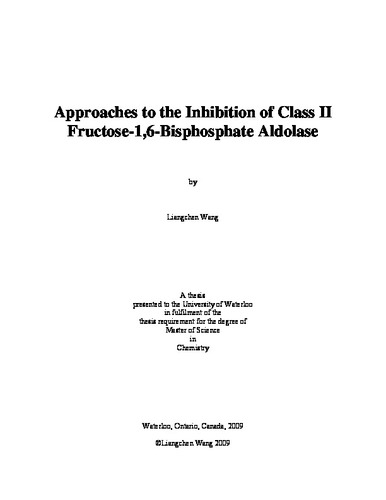UWSpace will be migrating to a new version of its software from July 29th to August 1st. UWSpace will be offline for all UW community members during this time.
Approaches to the Inhibition of Class II Fructose-1,6-Bisphosphate Aldolase
| dc.contributor.author | Wang, Liangchen | |
| dc.date.accessioned | 2009-05-22 18:21:37 (GMT) | |
| dc.date.available | 2009-05-22 18:21:37 (GMT) | |
| dc.date.issued | 2009-05-22T18:21:37Z | |
| dc.date.submitted | 2009 | |
| dc.identifier.uri | http://hdl.handle.net/10012/4457 | |
| dc.description.abstract | Fructose-1,6-bisphosphate (FBP) aldolase (E.C. 4.1.2.13) catalyzes the reversible aldol condensation of dihydroxyacetonephosphate (DHAP) and glyceraldehyde-3-phosphate (G3P) in glycolysis, gluconeogenesis and the Calvin cycle. FBP aldolases are categorized into two groups based on different catalytic mechanisms: Class I aldolases form a Schiff-base intermediate with the substrate through an active site lysine residue, whereas Class II aldolases contain a divalent metal which coordinates and stabilizes the carbanion intermediate. Notably, Class II aldolase does not exist in animals or plants, making this enzyme a potential drug target for pathogenic microbial organisms such as Mycobacterium tuberculosis, Pseudomonas aeruginosa, Magnaporthe grisea. A chromogenic substrate was synthesized as a FBP mimic from DHAP and 4-nitrobenzaldehyde catalyzed by a chiral primary-tertiary diamine-Brønsted acid catalyst that was synthesized in the optically active form. The chromogenic substrate can be applied to a direct chromogenic assay for monitoring the activity of Class II FBP aldolases and also to evaluate any good inhibitor. The catalyst was also synthesized in the racemic form that is ready for future asymmetric aldol reaction studies. In addition, our research group has found that a commercially available antidote for heavy metal poisoning, 2,3-dimercapto-1-propanesulfonic acid (DMPS) is a good competitive inhibitor of Class II FBP aldolase. In order to improve the binding affinity of this inhibitor in the enzyme active site, new molecules based on this compound, 1,1-difluoro-3,4-dimercaptobutylphosphonic acid, was rationally designed using molecular modeling. Attempts to synthesize this compound using our original synthetic plan were proven to be mostly unsuccessful. A new synthetic strategy was reasonably proposed for future reference. | en |
| dc.language.iso | en | en |
| dc.publisher | University of Waterloo | en |
| dc.title | Approaches to the Inhibition of Class II Fructose-1,6-Bisphosphate Aldolase | en |
| dc.type | Master Thesis | en |
| dc.pending | false | en |
| dc.subject.program | Chemistry | en |
| uws-etd.degree.department | Chemistry | en |
| uws-etd.degree | Master of Science | en |
| uws.typeOfResource | Text | en |
| uws.peerReviewStatus | Unreviewed | en |
| uws.scholarLevel | Graduate | en |

